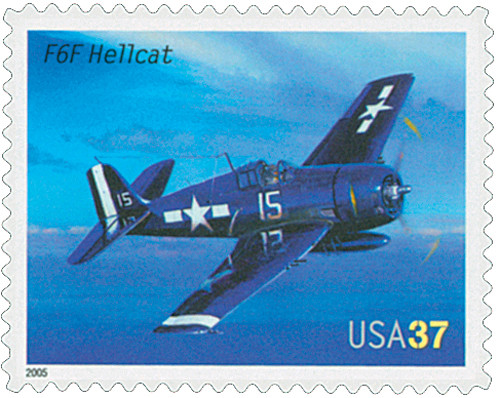
2005 37c Advances in Aviation: Republic P-47 Thunderbolt
# 3919 - 2005 37c Advances in Aviation: Republic P-47 Thunderbolt
$0.80 - $2.25
U.S. #3919
37¢ P-47 Thunderbolt
American Advances in Aviation
37¢ P-47 Thunderbolt
American Advances in Aviation
Issue Date: July 29, 2005
City: Oshkosh, WI
Printing Method: Lithographed
Color: Multicolored
City: Oshkosh, WI
Printing Method: Lithographed
Color: Multicolored
Republic Aviation built the P-47 Thunderbolt during World War II as a high-altitude escort fighter. Carrying three external fuel tanks allowed P-47s to accompany U.S. Army Air Force (AAF) bombers far into German territory and to travel the vast distances of Pacific Ocean operations. In a sustained dive, no other aircraft could stay with it.
In addition, Thunderbolts frequently attacked ground targets like tanks, airfields, and trains while returning from escort duty. Fast and heavily armed, the P-47 became the chief Allied low-altitude fighter-bomber.
The P-47 was the largest single-engine aircraft built during World War II. It was nicknamed the Juggernaut, or “Jug,” because of its huge size. Its sturdy construction and air-cooled radial engine enabled the Jug to sustain severe battle damage and keep flying. The rugged Thunderbolt protected the pilot in all but a nose-first crash.
The AAF acquired the P-47 in greater numbers than any other fighter. By the end of the war, more than 15,600 Thunderbolts had been built. During the war, P-47s were active in almost every theater of operations and in the forces of several Allied nations. Thunderbolts served with Air National Guard units until 1955.
U.S. #3919
37¢ P-47 Thunderbolt
American Advances in Aviation
37¢ P-47 Thunderbolt
American Advances in Aviation
Issue Date: July 29, 2005
City: Oshkosh, WI
Printing Method: Lithographed
Color: Multicolored
City: Oshkosh, WI
Printing Method: Lithographed
Color: Multicolored
Republic Aviation built the P-47 Thunderbolt during World War II as a high-altitude escort fighter. Carrying three external fuel tanks allowed P-47s to accompany U.S. Army Air Force (AAF) bombers far into German territory and to travel the vast distances of Pacific Ocean operations. In a sustained dive, no other aircraft could stay with it.
In addition, Thunderbolts frequently attacked ground targets like tanks, airfields, and trains while returning from escort duty. Fast and heavily armed, the P-47 became the chief Allied low-altitude fighter-bomber.
The P-47 was the largest single-engine aircraft built during World War II. It was nicknamed the Juggernaut, or “Jug,” because of its huge size. Its sturdy construction and air-cooled radial engine enabled the Jug to sustain severe battle damage and keep flying. The rugged Thunderbolt protected the pilot in all but a nose-first crash.
The AAF acquired the P-47 in greater numbers than any other fighter. By the end of the war, more than 15,600 Thunderbolts had been built. During the war, P-47s were active in almost every theater of operations and in the forces of several Allied nations. Thunderbolts served with Air National Guard units until 1955.
















